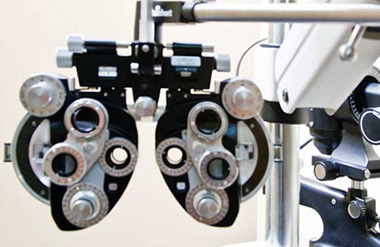|
Your vision and health is our primary
concern. We offer vision correction for
eye diseases and disorders which prevent
you from enjoying the world around you.
We specialize in treatment of a variety
of eye diseases such as macular
degeneration, glaucoma, and cataracts.

We also can
effectively correct vision conditions
such as myopia (near-sightedness),
hyperopia (far-sightedness),
astigmatism, and presbyopia.
If
you are diagnosed with an eye disease,
you want the best treatment available so
your eyes and your vision is healthy
again. We are proud of
and have earned our reputation of
offering unsurpassed treatment utilizing
the latest technology.
Whatever we recommend, you can be
assured that your vision is our primary
concern.
|
|
Case History.
When you come for a comprehensive eye
exam, you will be asked to describe any
vision problems you may have been
experiencing and any previous ocular
problems. We will also ask about your
general health, medications, allergies,
working environment, and hobbies.
Physical eye health
exam. The external and
internal parts of the eyes are examined
using specialized instruments including
slit lamp biomicroscope, direct and
binocular indirect ophthalmoscope in
conjunction with special focusing
lenses. Dilation of your pupils with eye
drops is frequently necessary for some
of these tests.
Refraction. This group of
tests determines your eyeglass and/or
contact lens prescription. We perform
precise measurements in several
different ways to determine the lens
formula that will work best for you.
Instruments used include a computerized
autorefractor, phoroptor and retinoscope.
Binocular vision
testing. We test your eye
coordination to ensure they work well
together and your vision is comfortable.
This includes an analysis of the eye
muscles used for movement, focusing and
depth perception. If you have a problem
with binocularity, your doctor may
correct it with prescription glasses
which may include prism and/or vision
therapy. Some cases require referral for
surgical treatment.
Tonometry. This is a
measure of the pressure inside the eye.
We offer several ways to do this test:
1) a new generation of air puff test
that is very gentle and quiet, 2)
Applanation tonometry (Goldmann,
Perkins, or Tonopen) touches the cornea
after anesthetic eye drops are
instilled. Elevated intraocular pressure
is a significant risk factor associated
with glaucoma.
Visual
field test. Every
comprehensive exam includes a screening
of your peripheral vision. It can help
diagnose or rule out neurological
disorders of the visual system and
traces the visual pathways from your eye
to your brain.
Retinal photography. A
special camera takes a digital color
photograph of the retina at the back of
your eye. This test is recommended on a
routine basis to provide your doctor
with a baseline record of the appearance
of your retina, internal blood vessels
and optic nerve. It is also used to
document both ocular and systemic
diseases as well as anatomical
abnormalities so they can be monitored
over time.
Treatment
& Plan. By understanding
how you use your eyes at work and
leisure, treatment options such as
corrective lenses, the need for
medications, additional testing required
or a referral for more specialized care
will be discussed. An opportunity will
be given to ask any questions you may
have about your eyes and vision. |